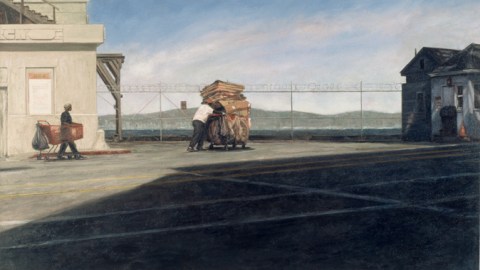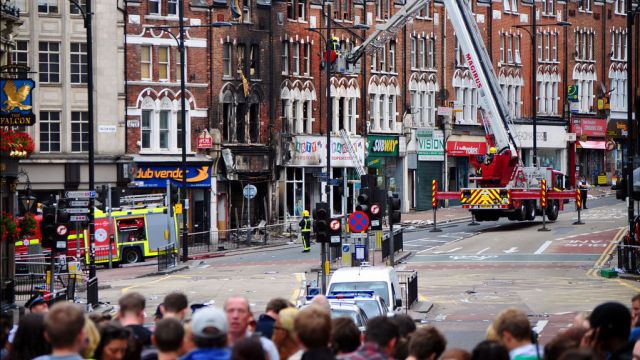How We Picture Homelessness

Homelessness in America is hard to picture for those of us who haven’t experienced it. Statistics on homelessness, like the definitions of the term, vary, but some estimate that 3.5 million people experience homelessness in a given year and about 842,000 people in any given week. Forty percent (and rising) are families with children, while 1.37 million of the total homeless population yearly are children under the age of 18, many of whom have no adult guardians. The homeless live in urban and rural settings, yet they seem invisible in any landscape. Hobos to Street People: Artists’ Responses to Homelessness from the New Deal to the Present, which runs through December 4, 2011 at the de Saisset Museum at Santa Clara University as part of a larger tour organized by the Western Regional Advocacy Program, aims to give a face to homelessness through the art of artists who have closely observed the homeless and, in some cases, been homeless themselves. How they picture homelessness through American history speaks volumes about how about how we picture homelessness. It also gives a visual “voice” to those who have no voice in the political debates that shape what kind of country we are, and will be.
Vagrants, transients, hobos, tramps, street people—the names the homeless have worn reflect more about cultural attitudes than about the displaced they try to describe. The exhibition slices the knotted issues of homelessness into four sections: daily realities, displacement, urban versus rural, and struggle and hope. Myths and misrepresentations fall away thanks to the short but powerful text accompanied by the impact of the art itself. The website includes sound clips from many of the artists sharing their thoughts as they created the different artworks. The art included begins during the Great Depression and stretches through World War II to today. During the Great Depression, “[a]rtists were not only observers, but they actively found ways to influence society through exhibition and distribution of their work,” the exhibition site explains. “During the decades following World War II artists shifted their energies elsewhere, but by the late 1970s with the rise of the modern era of mass homelessness many artists again began to focus on what was happening to poor people in our society. Structural changes in the American economy and a return to fiscally conservative ideology began a period of increased poverty and economic inequality.” Conservative critics will surely claim a liberal bias in the exhibition’s views, but the fact of homelessness across America remains, with plenty of blame to go around to all parties.
The juxtapositions between artworks across time and place add a special dimension to the show. Dorothea Lange’s 1939 photograph Mother And Two Children On The Road Tulelake, Siskiyou County, California seems a dusty museum piece about the rural poor until you see it paralleling David Bacon’s 2005 photo, San Diego, Indigenous women and children are part of the community of farm workers from Oaxaca, living in a camp on a hillside outside Delmar. The six-decade gap closes in seconds. Similarly, artists bridge time with powerful links such as the urban bridges that have loomed coldly above the homeless since the Great Depression. Homeless wait patiently for food beneath a bridge in Clare Leighton’s 1932 wood engraving Bread Line, while today’s homeless huddle around a makeshift fire beneath another bridge in Eric Drooker’s 2005 painting Under Bridges. Take some time to wander around the exhibition site and you’ll find similar associations soon crackling around your brain, firing your imagination, and troubling your conscience.
Familiar artist activists such as Giacomo Giuseppe Patri, Art Hazelwood, and Kiki Smith do their part. A panel from Patri’s landmark 1940 graphic novel White Collar reminds us of the wage slavery of the past, while Hazelwood’s 1996 take on Franklin Roosevelt’s Four Freedoms speech acidly depicts the broken promises of half a century before. With characteristic clarity and dark humor, Smith draws a pair of feet sticking out of box and titles it Home. Christine Hanlon’s 1998 painting Third Street Corridor (shown above) especially stuck in my mind. The sight of a homeless person pushing all his worldly belongings along a narrow corridor bordered by a concertina-wired fence on one side and the ominous shadow of an immense building on the other made me think of the Twenty-Third Psalm. “The Lord is my shepherd, I shall not want,” that psalm begins, ending with “Goodness and mercy all my life shall surely follow me. And in God’s house for ever more my dwelling place shall be.” In the valley of the shadow of death that is homelessness, these artworks all say a prayer for their subjects’ salvation, in this world or the next.
“The idea that artists through their art function in society by engaging in the struggle for a better world, and that everyone should take an interest in the well-being of less fortunate people are the twin beliefs of the artists in this show,” claims the conclusion to the exhibition. WRAP provides a handy “Take Action Page,” for those inspired to do something about this seemingly endless and seemingly worsening problem. The show has been touring in California since February 2009 and will move on to other sites in 2012, but even if you can’t get to see it live, experience it through the remarkable website. As Art Hazelwood’s 2006 graphic Spirit of Abandon shows, “From Reagan to Bush for Twenty-Five Years a Spirit of Abandon… America Has Abandoned its Spirit of Human Rights,” as federal funding for housing has plummeted from $16 billion in 1979 to less than $1 billion in 2003 and homelessness tripled or quadrupled in many U.S. cities just during the 1980s. Hobos to Street People: Artists’ Responses to Homelessness from the New Deal to the Present fights that abandonment furiously and thoughtfully, artfully, and fervently asks you to do the same.
[Image:Christine Hanlon (1954-present). Third Street Corridor, 1998. Oil on canvas. Courtesy of the artist. N.B.—You can hear the artist’s own thoughts on the painting here.]
[Many thanks to the de Saisset Museum at Santa Clara University for providing me with the image above and other press materials related to Hobos to Street People: Artists’ Responses to Homelessness from the New Deal to the Present, which runs through December 4, 2011.]





